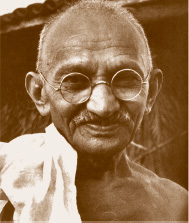

In an Upswing of “Me,” we quote Henry David Thoreau, that great individualist of Walden who said, “If a man does not keep pace with his companions, perhaps it is because he hears a different drummer. Let him step to the music which he hears, however measured or far away.”
We think, Oh, yes. It’s so meaningful! I will march to the beat of a different drummer. I will be my own person. I’m unique. I’m special. And by all that is holy, L’Oréal is right. I’m worth it! I have value. I’m a winner.
Motivational speakers get wealthy during a “Me.” Do you remember the popularity of positive thinking in the 1980s? The fact that yesterday’s “You can do it! You’re a winner!” crowd is currently making a fortune in China is just one more indication that Eastern culture swings “Me” when Western culture is swinging “We.”

CC Image
Gandhi, that selfless leader who united the people of India for the common good, was also inspired by Henry David Thoreau, but in a different way and from a different writing. Speaking of Thoreau, Gandhi said, “He taught nothing he was not prepared to practice in himself. He was one of the greatest and most moral men America has produced. At the time of the abolition of slavery movement, he wrote his famous essay, ‘On the Duty of Civil Disobedience.’ He went to jail for the sake of his principles and suffering humanity. His essay has, therefore, been sanctified by suffering.”
It is, of course, no coincidence that Thoreau wrote his famous essay in 1849, during the seventh year of an Upswing in a Western “We.”
It’s common to see suffering as a virtue when we’ve passed the Zenith of a “We,” but Gandhi made his “suffering is good” statement in 1907, very near the Zenith of the Western “Me” of 1903. This is another subtle indication that the Pendulum of the East hits the Zenith of “We” just as the West hits the Zenith of “Me.” Gandhi, in the Eastern “We” of 1903, was inspired by Thoreau’s civil disobedience and took it to a whole new level.
The next Eastern Zenith of “We” was 1983. Their “Me” Zenith will be 2023. We expect 2023 in Asia to look very much like 1983 looked in America.
So if China and India are swinging “Me” while Western society is swinging “We,” might there be a practical, productive, profitable use for this information?
Of course there is. If you want to sell products or services in China or India, study the techniques that were effective in the United States exactly forty years ago. Forty-year-old magazines, books, and newspapers will be your best sources of inspiration. Sales and promotional techniques that were effective in the United States in 1972 will be similarly effective in China and India in 2012. Just make the necessary adjustments for language and culture, then reintroduce your historically proven technique. You’ll be hailed as a marketing genius.
Or maybe our theory is wrong, and you’ll look like an idiot. You decide.
Let’s talk a bit more about marketing.
Ernest Dichter (1907–1991) was an American psychologist and the marketing expert who is considered to be the father of motivational research. In the December 1966 issue of Harvard Business Review1, Dichter identified the four basic motivators that drive consumers to talk about their experiences with products and product messages.
1. Product-involvement. The experience is so novel and pleasurable that it must be shared. Dichter estimated that product involvement drives one-third of all discussions about products.

iStockphoto / kupicoo
2. Self-involvement. This is a way to gain attention, demonstrate connoisseurship, identify oneself as having insider status, or assert superiority over others. Dichter estimated that self-involvement drives nearly a quarter of all discussions.
Keep in mind that Dichter conducted this study in 1966, during the Upswing of a “Me.”
3. Other-involvement. This is a desire to express neighborliness, caring, and friendship. In a “Me,” other-involvement drives less than one-fifth of purchases.
4. Message-involvement. The information is so humorous or informative that it cries out to be shared. Again, in a “Me,” message-involvement drives slightly less than one-fifth of purchases.
We can easily conclude from Dichter’s study that product-involvement and self-involvement would be the keys to selling in India and China, as they seem to be currently swinging toward “Me.”
1. Does other-involvement gain importance during a “We”? Should American marketers get involved with saving the environment and other social issues? Successful ad campaigns of recent years would lead us to believe this answer to be Yes.
2. Does message-involvement gain importance in a “We”? Should American marketers invest in messages that are notable for their humor and perspective? The success of Facebook and Twitter would seem to indicate this answer to be Yes as well.
Here’s what marketing looks like during a “We”: a woman is shopping with her boyfriend for engagement rings in one of the ten thousand–square-foot showrooms of Spence Diamonds. She steps into the ladies room, where she finds the following message on the wall. It’s an example of “other-involvement” as described by Ernest Dichter.
WE So this is it. Wow. You’re about to choose the ring you’ll wear forever. And that guy out there is The One. Not exactly how you used to imagine him, is he? Don’t let it bother you. Men have been falling short of women’s expectations for centuries. But somehow it all works out. The secret is to look past all his outward bravado and awkwardness to see the boy he is inside. Seriously. Little girls grow up and become adults. Boys, well, they just get taller. You know, it’s not too late to go out there, look him in the eye, and say, “I’ve changed my mind.” Life without him would be a lot less complicated, that’s for sure. The house would stay cleaner, the bills would be smaller, and you wouldn’t have to be forgiving him constantly for all those idiotic things men do. Maybe you could get a cat. I’ve heard cats make good companions. But then, however, he does make you laugh. Cats don’t do that. And you know he’d jump in front of a train to save you. He sees something magical in you. That’s why he’s out there, right now, waiting. Feels good, doesn’t it? So what’s it going to be—a cleaner house or a life of adventure? If you choose the adventure, go out that door and surprise him with a kiss. Don’t tell him what it’s for. Let it be just another small part of the wonderful mystery that is you.
Did you notice that this message on the stall of the ladies bathroom in Spence Diamonds contains no information about the company or its products? This strange piece of writing illustrates the difference between pulling people into a relationship through positive attraction as opposed to pushing them into a decision through a “needs analysis” and then “overcoming their objections.”
Pull works better than push during a “We,” even when you’re writing ads for classic mass media like signage, television, radio, and newspaper.
The “push” strategy of direct marketing did exceptionally well during the last “Me,” but the old gurus of direct marketing saw their businesses fall apart at the end of the 2003–2008 transitionary window into the current “We.”
ME = Push
WE = Pull
2003–2043 will be a “We” for all of Western society.
People assume the Internet and social media are driving today’s society. The truth, however, is quite the opposite: it is our “We” society that is driving both the Internet and social media.
WE |
The Internet is not a sales or marketing tool; rather, it is a relationship-building device. |
Online relationships are built through conversation, just as they have always been built offline.

iStockphoto / RapidEye
The Internet is a “pull” medium, serving up only what is requested. Successful online marketing is based on creating an appropriate response to the actions or inquiries of the customer. It is barely conceivable in the online world that a marketing strategy might be crafted to “push” a customer into taking action. Yet a large number of marketers are still trying to use yesterday’s “push” tactics online.
A dynamic “Me” personality believes in “overcoming objections.” Selling is combat—push.
A responsive “We” personality believes in “positive attraction.” Selling is seduction—pull.
Business Insider tells us that 96 percent of Americans use Facebook, and Edison Research adds that forty-six million of us check our social media profiles daily. Do you have a place in social media? Remember: it’s not about marketing, it’s about conversation and relationship. Don’t pound your visitors; instead, seduce them into spending time with you. Whoever wins their time is the one most likely to win their money.
The slogans of McDonald’s, the most successful franchise in the history of marketing, reflect an uncanny sensitivity to the mood of the public.
Figure 18.1 Popular slogans are a reflection of the current cycle.

iStockphoto / Veni
Figure 18.2 Characteristics of effective sales methods in a “ME” cycle versus those in a “WE” cycle.
| WE | VERSUS | ME |
| SELLING/MARKETING IN A “ME” VERSUS A “WE” | ||
| “CUT THE CRAP AND GIVE IT TO ME STRAIGHT.” | “YOU’RE SELLIN’ HOPE, AND I’M BUYIN’ IT LIKE IT’S CRACK COCAINE.” | |
• Pull |
• Push |
|
• Positive Attraction |
• Overcoming Objections |
|
• Selling is Seduction |
• Selling is Combat |
|
• Authenticity |
• Self Confidence and Belief |
|
• Reality and Truth |
• Advertising Specials |
|
• Steak |
• Sizzle |
|
Do these things and your business will soar.